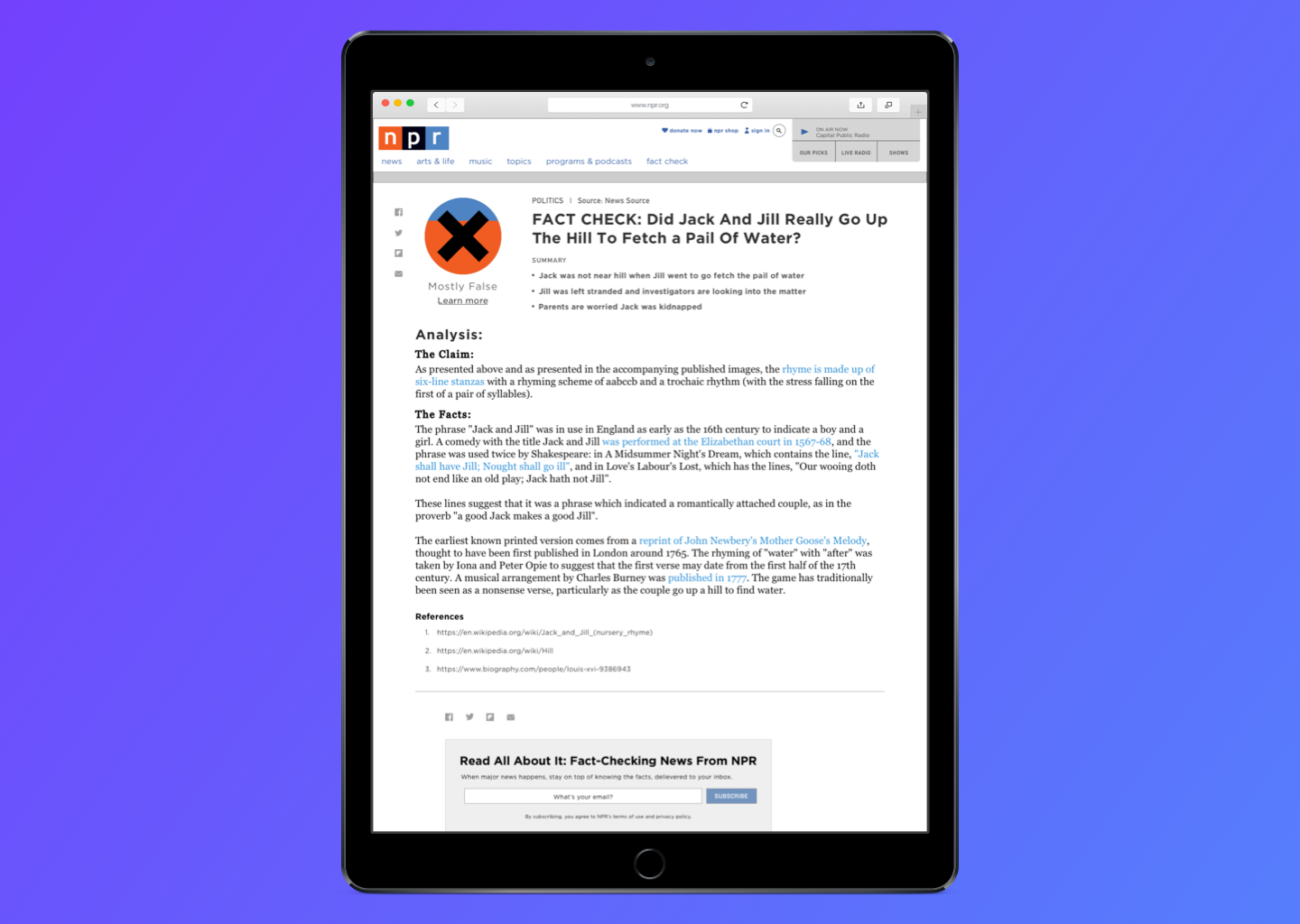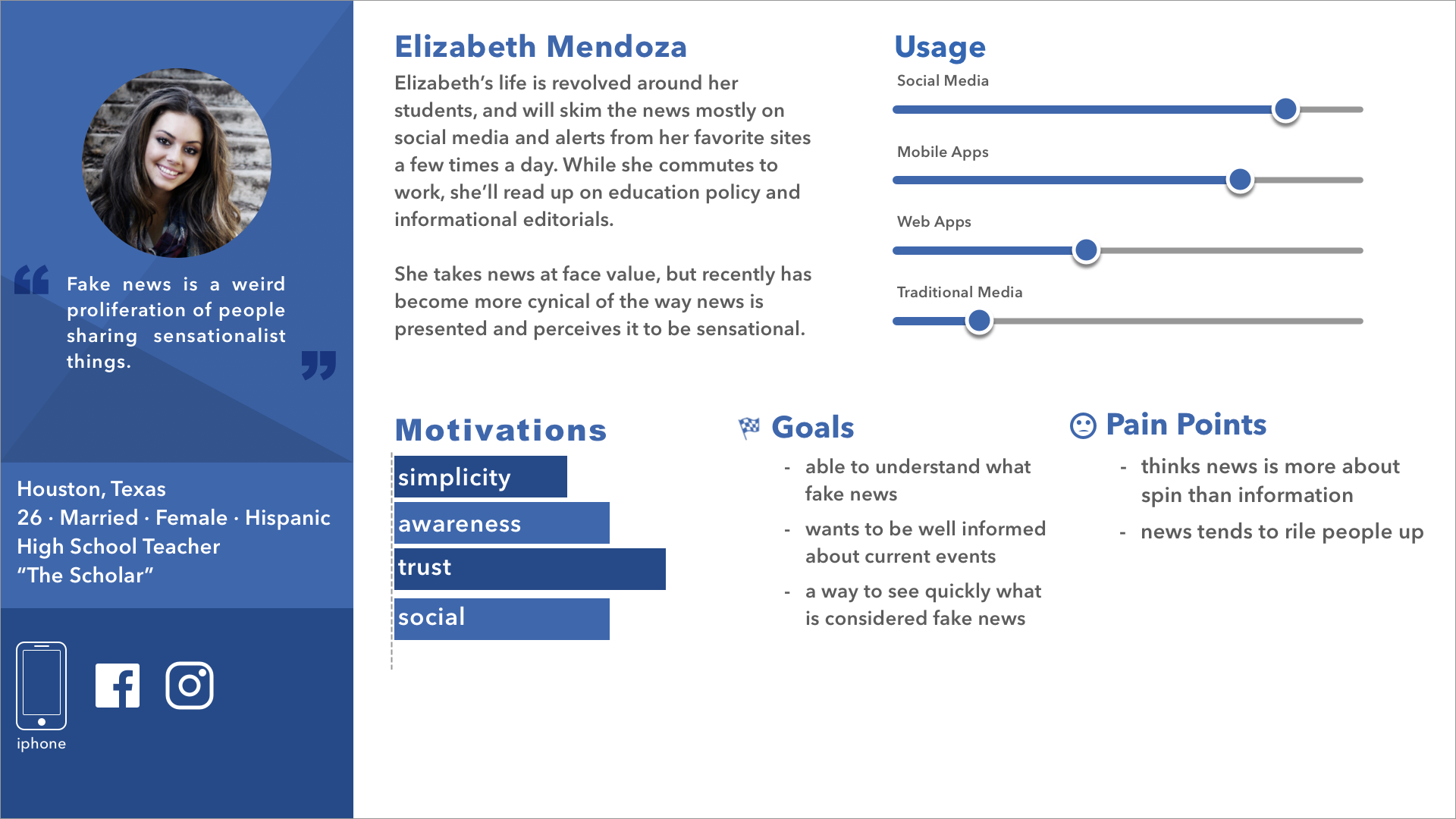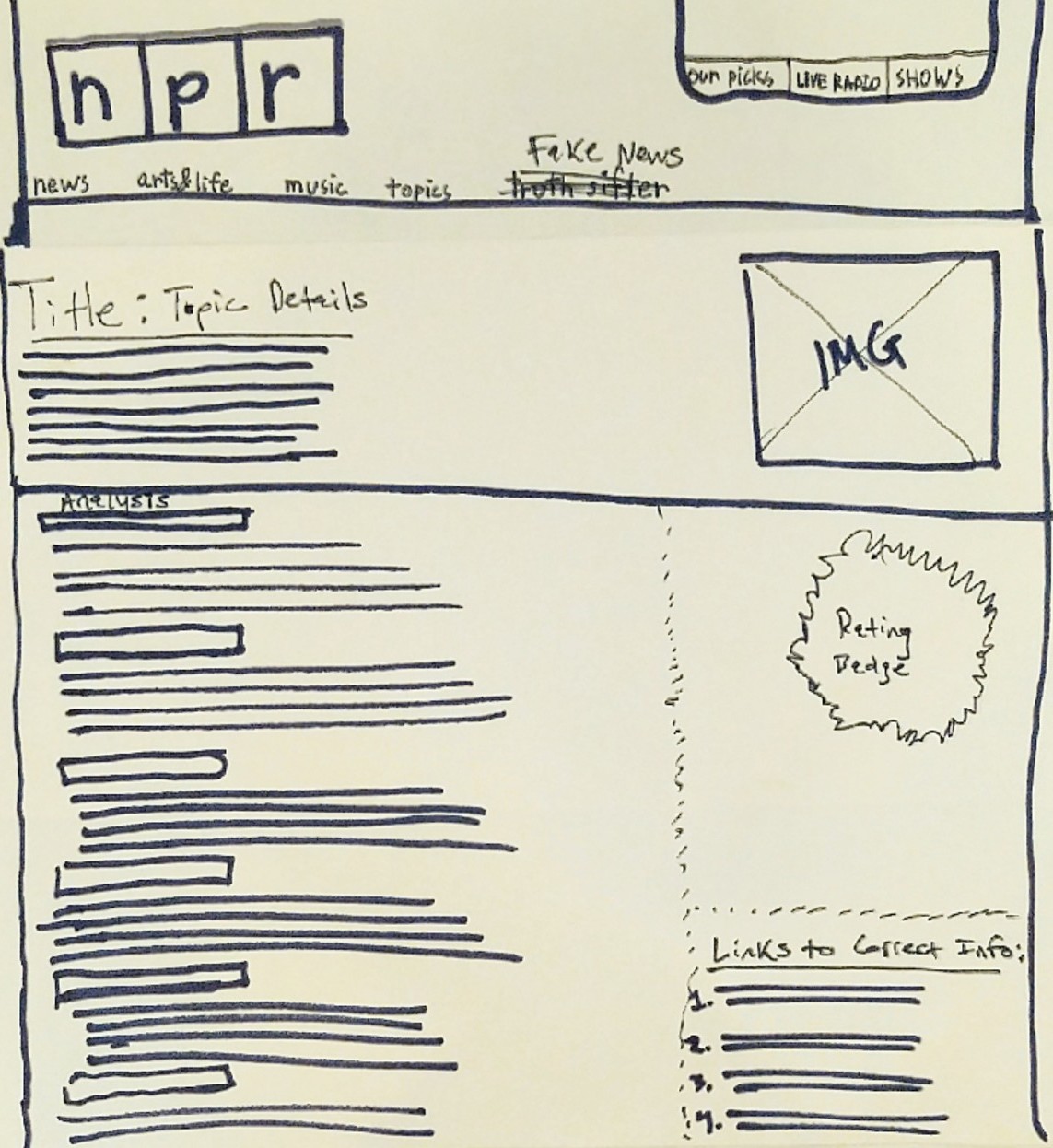Fighting Fake News
Fake News is a growing issue that affects everyone, especially in this rapidly expanding world of interconnectivity and information sharing. This is how NPR can provide a platform that flags fake news topics, and educates their readers about reputable news sources.
NPR already distributes news and cultural programming to tens of millions across the globe. As a media organization known for their reputability, our aim was to create a platform that enables NPR staff to inform and educate their audience about fake news topics that are trending around the world.
Goals
Design an NPR platform that makes it easy for users to identify and edcuate themselves about fake news topics.
Performance Indicators
SUS of final prototype >“A” grade
Responsibilities
End-to-end research, design, testing
Design an NPR platform that makes it easy for users to identify and edcuate themselves about fake news topics.
Performance Indicators
SUS of final prototype >“A” grade
Responsibilities
End-to-end research, design, testing
Timeline
2 Weeks
Team
3 Designers
Disclaimer
Passion project—prototypes are not actual NPR products.
2 Weeks
Team
3 Designers
Disclaimer
Passion project—prototypes are not actual NPR products.
New Designs
A list view of trending fact check articles
A new ‘fact check’ section on NPR’s site lists controversial news topics with truthfulness badges for easy scannability.

Article details view with references to factual information
Provides users a full analysis on the truthfulness rating and gives citations to factual information & reputable sources.

User Research
“When deciding to believe news that I read, I need to see more sides of the same story.”
-User Interview
Interviews
We needed to talk to everyday people to understand their news consumption habits.
I interviewed a dozen individuals from the San Francisco Bay Area, with a goal to gauge awareness of fake news, and see the general willingness to fact-check.
We also conducted a 23-question survey through our network, synthesizing results from over 50 participants.
We also conducted a 23-question survey through our network, synthesizing results from over 50 participants.
“How do you get your news?”
“Do you seek out news? Or are you exposed to it throughout the day? Why?”
“Do you fact-check news that you read? How? And how often?“
“When do you question the truthfulness of news that you read?”
52
Survey respondents12
User interviews3
Hours of interviews8+
Hours of data synthesisFindings

We synthesized our interview feedback on an Affinity Map to capture the motivations and preferences of our users. After comparing with our survey data, we distilled our findings into a few key focus areas that became the basis of our design:
People take a low effort approach to news
- Many people consume news when it's convenient for them.
- Usually through app updates from trusted sources, or sometimes just social media.
Those who fact check want to see more sides of the same story
- We also found that skeptical users tend to make a web search for varying reports on news topics.
- They find that coverage from reputable sources helps determine their belief in news.
Scannability is important when reading or fact checking news
- Our survey data revealed that users favor scannability when checking news articles, or even when determining whether a news topic is fake or not.
Inspiration
![]()
Our market research revealed various existing fact-checking tools on the web.
However, these products lacked reputability, usability, and scannability.
We thought carefully about how to adapt some of their most impactful features into a reputable NPR solution.
We were particularly inspired by:
However, these products lacked reputability, usability, and scannability.
We thought carefully about how to adapt some of their most impactful features into a reputable NPR solution.
We were particularly inspired by:
- The way certain sites evaluate and rate news for trustworthiness.
- How certain sites educate users on red flags to catch when reading news.
- The consistency of supporting sources in a fact check analysis
Satisfying Personas
Based on research insights, we created user personas for two separate news consumers. Their goals and pain points represent feedback gathered from interviews and survey data.


Focus Areas
We brainstormed a set of features based on our research, and settled on a dedicated NPR 'Fact Check' resource that evaluates news topics with:
A list view of articles with summaries
A badge that rates the truthfulness of the news topic
A details page with a full analysis, and references to other factual sources
Prioritizing features on a MoSCoW Table
Satisfying 4 Major Needs
Low effort, easy to access and scan
Integrate into existing news habits, leveraging NPR's existing platform
Emphasize credibility through NPR and other reputable sources
Varying levels of detail to cater to different user habits
Build and Test
Paper Prototyping
We started developing user interfaces, combining the best elements into a paper prototype.







We conducted 6 paper prototype tests to determine the best details page, and see where users were having trouble with our navigation and structure.
Wireframing
With our prototype insights fresh in mind, I worked with a teammate wireframe our solution with a fresh layout. Some example content was added to give stronger context to our users in the upcoming usability tests.
User Testing
After turning our wireframes into a clickable prototype, we tested it on 4 users with a few repeatable tasks navigating our design.
4
Fresh users7
Repeatable tasks8
Problem areas identified6
Changes madeIncorporating Insights
We then made changes to our wireframes by incorporating feedback from our user testing, as noted below:


Final Designs
After testing our revised prototype with more unique users, I developed our lo-fi wireframes into high fidelity mockups.
Our new testers noted that they wanted to see example badges, along with images to go along with content.
Our new testers noted that they wanted to see example badges, along with images to go along with content.


Outcomes
Throughout our design process and testing, we gave System Usability Scale surveys to our testers after each iteration of our prototype.
Although our initial paper prototype scored a below-average 67.08 points, our final wireframes scored much higher at 87 points, demonstrating substational improvement in our design.
SUS: “A”
Final System Usability Score (87) for fact-check navigation and details page (web)
